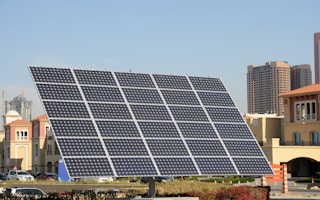A silent revolution is under way. In November, Dubai announced the construction of a solar energy park that will produce electricity for less than $0.06 per kilowatt-hour – undercutting the cost of the alternative investment option, a gas or coal-fired power plant.
To continue reading, subscribe to Eco‑Business.
There's something for everyone. We offer a range of subscription plans.
- Access our stories and receive our Insights Weekly newsletter with the free EB Member plan.
- Unlock unlimited access to our content and archive with EB Circle.
- Publish your content with EB Premium.
The plant – which is expected to be operational in 2017 – is yet another harbinger of a future in which renewable energy crowds out conventional fossil fuels. Indeed, hardly a week seems to pass without news of a major deal to construct a solar power plant. In February alone, there were announcements of new solar power projects in Nigeria (1,000 megawatts), Australia (2,000 MW), and India (10,000 MW).
There can be no doubting that these developments are good for the fight against climate change. But the major consideration driving them is profit, not the environment, as increased efficiency in energy distribution and, where necessary, storage, reduces the cost of producing renewable energy.
As efforts to improve the management of electricity from fluctuating sources yield further advances, the cost of solar power will continue to fall. Within ten years, it will be produced in many regions around the globe for 4-6 cents per kilowatt-hour, according to a recent study by the Fraunhofer Institute for Solar Energy Systems (commissioned by the think tank Agora Energiewende). By 2050, production costs will fall to 2-4 cents per kilowatt-hour.
As Patrick Graichen, Agora’s executive director, points out, most forecasts of the world’s future energy supply fail to take into account solar power’s looming victory over its fossil-fuel competitors. Updating them would paint a realistic picture of the costs and impact of our energy production and consumption on the world’s climate, reveal the importance of renewable energy to economic development, and enable better planning of energy infrastructure.
We should not underestimate the tremendous potential the sun and wind have for building global wealth and fighting poverty. As solar power becomes increasingly cost-effective, countries located within the planet’s sun belt could develop entirely new business models as cheap, clean energy enables them to process their raw materials locally, adding value – and profit – prior to export.
“
There can be no doubting that these developments are good for the fight against climate change. But the major consideration driving them is profit, not the environment, as increased efficiency in energy distribution and, where necessary, storage, reduces the cost of producing renewable energy.
Unlike large-scale conventional power plants, solar installations can be built in months; in addition to being cost-effective, they provide a quick means of responding to growing global demand. And, because solar plants can generally be operated independently of complex interregional electricity grids, they provide less developed countries a way to electrify their economies without building expensive new infrastructure.
Solar power plants thus could play the same role for energy that mobile phones did for telecommunications: rapidly reaching large, underserved communities in sparsely populated regions, without the need to invest in the cables and accompanying infrastructure that once would have been necessary. In Africa, 66% of the population has gained access to electronic communications since 2000. There is no reason why solar power could not do likewise for access to electricity.
The time to invest in large-scale solar energy production is now. For starters, construction costs for solar power plants are finally low enough to produce electricity at a competitive, stable price for more than 25 years. The price of oil may have plunged for now, but it will rise again. Solar power plants provide insurance against fossil fuels’ inherent price volatility.
Even more important, the cost of capital currently is very low in many countries. This is a decisive factor for the economic viability of solar power plants, because they need very little maintenance but require relatively high upfront investment. The Fraunhofer study shows that differences in capital expenditure are as important for costs per kilowatt-hour as differences in sunlight. Solar power is currently cheaper in cloudy Germany than in sunny regions where the cost of borrowing is higher.
The amount of sunlight that shines on a country is impossible to change. But the cost of capital is something over which a country can maintain a certain amount of control. By creating a stable legal framework, providing credit guarantees in the context of international agreements, and involving central banks in large-scale investments, governments can help to make solar power more accessible.
Factors like these explain why international climate policies increasingly focus not only on solar power, but on other forms of renewable energy as well. Technological breakthroughs have boosted these energy sources’ competitiveness relative to fossil fuels. As a result, instruments that make their adoption more affordable are becoming some of the most important weapons we have in the fight against climate change.
Klaus Töpfer, former Executive Director at the United Nations Environment Programme, former Under-Secretary-General of the United Nations, and a former German environment minister, is Executive Director at the Institute for Advanced Sustainability Studies in Potsdam and Council Chair at Agora Energiewende.
Copyright: Project Syndicate, 2015.
www.project-syndicate.org











